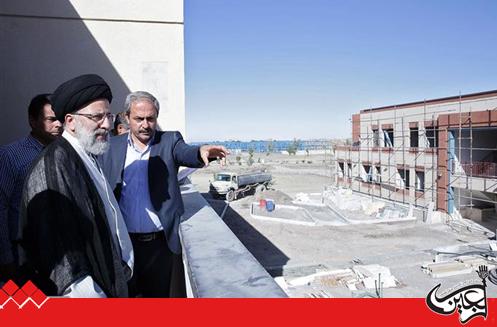Hujjat al-Islam Sayed Ebrahim Raeisi recounted Razavi Pilgrim City as a residence place for low-income pilgrims of Imam Reza (A.S.) and said, “The title ‘Pilgrim City’ indicates that many essential and urgent services of pilgrims have been provided. The project started in Ramadan month in 2016 and we hope the phase I of the project could be inaugurated this year during the Razavi Karamat days.”
“Engineers, workers, and those involved in the project worked hard throughout one year in different atmosphere conditions to establish a lasting building and today this big project with the capacity of accommodating 5000 pilgrims all day and night was put into operation”, Grand Custodian of Astan Quds Razavi remarked.
Stressing on using Iranian goods in the Razavi Pilgrim City project, he asserted, “We undertook to make use of only Iranian goods and building materials in this project unless there was no Iranian alternative, or using Iranian sample was impossible.”
Grand Custodian of Astan Quds Razavi recounted the Razavi Pilgrim City project as a manifestation of employment and production and remarked, “This project is a manifestation of production in line with producing temporary dwelling for Razavi pilgrims and the employment in the construction domain. Building is among the leading economies that provokes many other jobs and employment opportunities.”
Expecting for traffic reduction in the center of the city through initiation of the Razavi Pilgrim City project, he reiterated, “With respect to the problem of insufficient parking lots especially in the center of the city and around the Razavi Holy Shrine, we hope pilgrims could attend the Razavi Holy Shrine assuredly by parking their cars in the Razavi Pilgrim City and using public transportation to reach the Holy Shrine.”
Referring to the importance of public participation in implementation of benevolent and public utility projects, Hujjat al-Islam Raeisi said, “When public participation occurs in a project, besides carrying out the project in the best way by people, valuable cultural effects also will ensue; despite no evident public call for this project, many benevolent people, however, took part in the project actively.”
Noting that the land of the project belongs to Imam Reza (A.S.), and the benevolent people contributing in its establishment are in fact servants of Imam Reza (A.S.), Grand custodian of Astan Quds Razavi said, “We are going to mount a tableau at the place of the project containing the names of the benevolent and the involved organizations after the project finished.”
It is notable that in this visitation, Hujjat al-Islam Raeisi along with a number of deputies and managers of Astan Quds Razavi visited the under-construction building projects of the phase I of the Razavi Pilgrim City project, and the technical and construction deputy of Astan Quds Razavi Endowments presented explanations about the quality of designing, implantation, and applications of the buildings.
Sunday 21 December 2025

